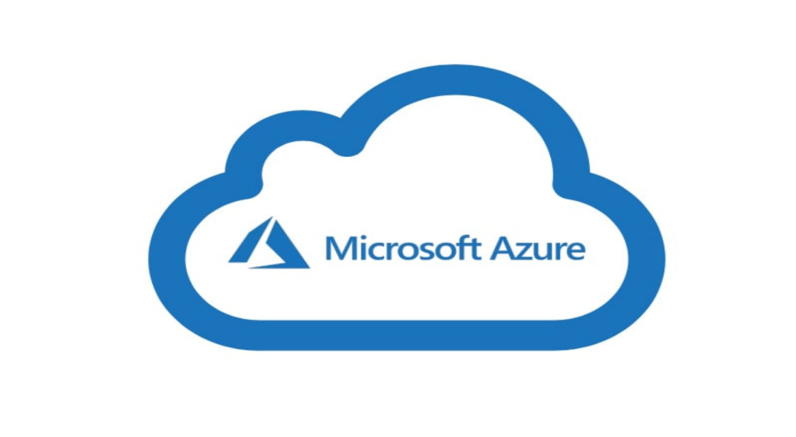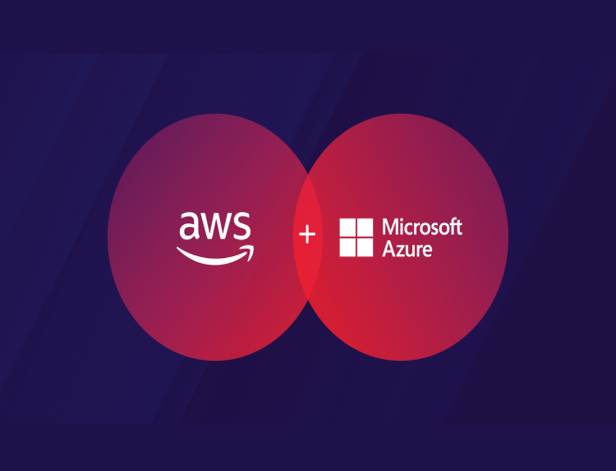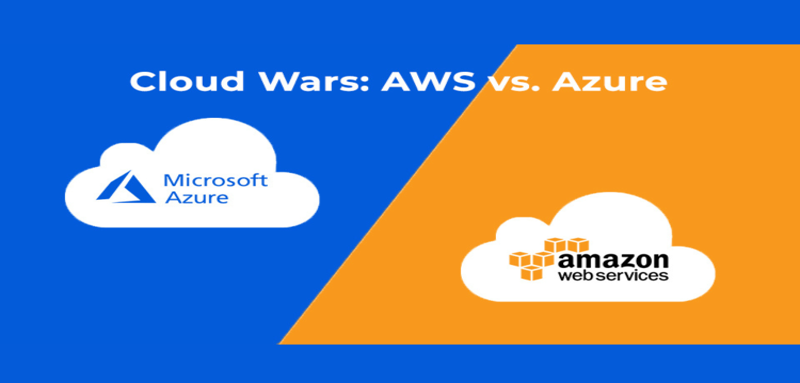Hey Guy’z Look Microsoft Azure and AWS Cloud Computing
So Lets See

Unleashing the Power of the Cloud: A Closer Look at Microsoft Azure
In today’s fast-paced digital world, cloud computing has become an indispensable tool for businesses and organizations of all sizes. One of the major players in the cloud computing arena is Microsoft Azure. With a wide array of services and solutions, Azure has been a game-changer for many companies, offering scalability, flexibility, and reliability. In this blog, we will take a closer look at Microsoft Azure and explore why it has become a go-to choice for cloud computing needs.
Unlocking the Power of AWS Cloud: A Comprehensive Guide
In today’s rapidly evolving digital landscape, cloud computing has become an integral part of businesses and organizations of all sizes. Among the many cloud service providers, Amazon Web Services (AWS) stands out as a top choice for its scalability, reliability, and extensive range of services. In this blog, we will explore the world of AWS cloud, its key features, benefits, and use cases.
Elucidation of Microsoft Azure Cloud Computing
Microsoft Azure is a cloud computing platform and infrastructure provided by Microsoft. It offers a wide range of cloud services, including computing, analytics, storage, and networking. Azure allows businesses to build, deploy, and manage applications and services through Microsoft-managed data centers spread across the globe. This global presence provides scalability and reliability, making it a top choice for businesses aiming to reach a global audience.


Explication of AWS Cloud Computing
Amazon Web Services, commonly referred to as AWS, is a cloud computing platform offered by Amazon.com. It provides a broad set of infrastructure services, such as computing power, storage, databases, machine learning, and more. AWS’s global infrastructure spans across regions and availability zones, making it accessible to businesses worldwide.
Global Reach, Robust Infrastructure
Azure’s global network of data centers and robust infrastructure is a cornerstone of its appeal. This extensive reach ensures that your applications and data are always close to your users, leading to improved performance and reduced latency. Moreover, Azure’s infrastructure is built for reliability and scalability, offering peace of mind to businesses of all sizes.


Security and Cost-Effectiveness
In today’s digital landscape, security is paramount. Azure Cloud Compute places a strong emphasis on safeguarding your data and workloads. With a plethora of security features and compliance certifications, Azure provides a secure environment for your applications and data.Cost management is another critical aspect of cloud computing. Azure offers various tools and resources to help you optimize your spending, allowing you to pay only for the resources you use.

Getting started with Amazon Web Services
(AWS) is a straightforward process. Begin by creating an AWS account on their website, providing payment information (though many services have a free tier for new users). Next, choose a region where you want to deploy your resources, considering your audience’s proximity.

Explore the diverse array of AWS services to understand which ones suit your specific needs. Set up security using AWS Identity and Access Management (IAM) to control access to your resources and implement security best practices. With these foundational steps in place, you can start building your applications and infrastructure in the AWS cloud, benefiting from its scalability and robust infrastructure.
So Lets See
How does AWS Cloud Computing And Azure work?
AWS (Amazon Web Services) and Azure (Microsoft Azure) are leading cloud computing platforms that function by providing businesses and individuals with a vast array of on-demand IT services and resources over the internet. They operate on a global network of data centers, each divided into multiple availability zones, ensuring redundancy and high availability. Users can access these cloud resources to build, deploy, and manage applications, data, and services.
When an organization or individual wants to use cloud computing, they can create virtual servers, store data, run applications, and leverage various services provided by AWS and Azure. These services encompass computing power, storage, databases, networking, analytics, artificial intelligence, and more. Users can scale their resources up or down as needed, paying only for what they use.
Both AWS and Azure offer security features, including encryption and identity and access management, to protect data and applications. This cloud-based infrastructure allows businesses to be more agile, cost-effective, and responsive to changing demands, making it a foundational technology for the modern digital era. Users can choose from a wide range of services and tools to create and manage their cloud-based solutions, providing the flexibility needed to meet their specific goals and requirements.
Use daily life cases of Microsoft Azure and AWS Cloud Computing

Both Microsoft Azure and Amazon Web Services (AWS) have integrated seamlessly into our daily lives, often behind the scenes, powering various services and applications. Consider Microsoft Azure, which plays a pivotal role in many organizations’ productivity tools like Microsoft Office 365.
When you collaborate on documents or communicate via Microsoft Teams, Azure’s cloud infrastructure is working to ensure these applications are available and responsive. On the other hand, AWS frequently supports popular content streaming services like Netflix and Disney+, allowing us to enjoy our favorite movies and shows. It’s the invisible backbone ensuring that high-quality content is delivered reliably and efficiently to our screens. In essence, both Azure and AWS impact our daily lives by enabling the digital tools and entertainment experiences we often take for granted, emphasizing the profound influence of cloud computing in our increasingly interconnected world.
Role Of Microsoft Azure and AWS Cloud Computing
Microsoft Azure and Amazon Web Services (AWS) are two industry giants that play critical roles in modern cloud computing. Azure, developed by Microsoft, offers a wide spectrum of cloud services, including computing, analytics, databases, and more, while AWS, provided by Amazon, is known for its extensive range of infrastructure and application services.

Together, these platforms power a significant portion of the internet and underpin a vast array of digital services. Azure is deeply integrated with Microsoft products like Windows Server and Office 365, serving as a reliable and secure foundation for businesses to run applications and store data. AWS, on the other hand, is the backbone of popular streaming services, e-commerce platforms, and countless other applications that require scalability and high availability. Both Azure and AWS contribute to the growth of artificial intelligence, machine learning, and the Internet of Things by providing the necessary infrastructure and tools. Their role is pivotal in enabling businesses and individuals to innovate, scale, and operate efficiently in today’s digitally connected world.
YOU KNOW?
Why is AWS popular than azure?
Amazon Web Services (AWS) enjoys broader popularity than Microsoft Azure in several key areas. One of the primary reasons for AWS’s greater popularity is its early entry into the cloud computing market, which allowed it to establish a significant foothold. As a result, many startups and enterprises initially adopted AWS, creating a robust user base. Furthermore, AWS has consistently expanded its service offerings, covering a vast spectrum of cloud solutions, which caters to a broad range of use cases. AWS’s global network of data centers and its track record of reliability and high availability have also contributed to its popularity, particularly in industries where these factors are crucial, such as streaming, e-commerce, and gaming.
AWS’s ecosystem of tools and a vast marketplace for third-party integrations has attracted a diverse community of developers and partners, fostering innovation and growth. The availability of AWS certifications and a strong developer community has further established it as a go-to choice for cloud computing solutions. While Microsoft Azure has its own strengths, such as tight integration with Windows-based systems and a strong enterprise focus, AWS’s extensive and adaptable services, coupled with its early-mover advantage, continue to make it the more popular choice for a wide range of cloud computing needs.


Prospects of Azure Cloud And AWS Cloud Computing
AWS:
1.Expanding AI and machine learning capabilities.
2.Focusing on sustainability and green data centers.
3.Strengthening cybersecurity services.
4.Advancing IoT solutions and edge computing.
Microsoft Azure:
1.Enhancing hybrid cloud solutions.
2.Investing in quantum computing research.
3.Expanding cloud gaming with Azure PlayFab.
4.Developing industry-specific cloud offerings.
Which is better in terms of pricing?
The determination of whether AWS or Microsoft Azure offers better pricing in the context of cloud computing depends on various factors, including the specific requirements of an organization and the services they intend to use. Both AWS and Azure have competitive pricing models, and their cost structures can be complex due to the variety of services offered. In some cases, AWS might have a more straightforward pricing model, which makes it easier for users to estimate costs. Azure, on the other hand, may be more cost-effective for organizations heavily invested in the Microsoft ecosystem, as it offers seamless integration with Microsoft products. However, for startups and businesses with fluctuating workloads, AWS’s pay-as-you-go pricing model can be advantageous.
It’s crucial for businesses to conduct a detailed analysis of their anticipated cloud usage, considering factors like data transfer, storage, and computational needs, to make an informed decision about which provider offers the best pricing for their specific use case. In essence, the choice between AWS and Azure is highly dependent on individual circumstances and demands a careful evaluation of pricing, features, and ecosystem compatibility.

Benefits and Features
Microsoft Azure and AWS offer a host of benefits and features that cater to diverse cloud computing needs. Azure excels in its tight integration with Microsoft products, making it an excellent choice for businesses already invested in the Microsoft ecosystem. It offers robust hybrid cloud solutions, advanced AI and machine learning capabilities, and comprehensive support for enterprise applications. AWS, on the other hand, leads in terms of early market entry and breadth of services. It provides a pay-as-you-go pricing model, strong security features, and high availability with a global network of data centers. Both cloud platforms offer scalability, reliability, and an extensive array of services, enabling businesses to innovate, grow, and streamline their operations in the digital age. The choice between Azure and AWS depends on individual requirements and ecosystem compatibility.
Job Opportunities
AWS and Microsoft Azure cloud computing platforms offer abundant job opportunities across various roles in the IT industry. As organizations increasingly migrate to the cloud, the demand for cloud architects, engineers, and developers with expertise in AWS and Azure has surged. Cloud administrators manage and optimize cloud resources, while cloud architects design and implement cloud solutions tailored to specific business needs. DevOps engineers ensure seamless integration and deployment. Data scientists and AI engineers leverage cloud services for analytics and machine learning. Cloud security experts are essential to protect data and applications. The growth of IoT and edge computing also opens up new career prospects. In essence, the job market for AWS and Azure professionals is flourishing, making it an attractive field for IT enthusiasts and professionals seeking diverse roles.
Diverse Computing Options
AWS and Microsoft Azure provide diverse computing options to meet a wide range of needs. AWS offers Amazon EC2 for scalable virtual servers and Lambda for serverless computing. Azure provides Azure Virtual Machines and Azure Functions for similar capabilities.

Both platforms support containerization through services like AWS Elastic Container Service (ECS) and Azure Kubernetes Service (AKS). For high-performance computing, AWS offers EC2 instances with GPU support, while Azure provides Azure Batch. Additionally, Azure has a strong focus on hybrid cloud solutions, making it suitable for organizations with on-premises data centers. Both AWS and Azure offer extensive services for AI, machine learning, and IoT, catering to various industries and use cases, allowing users to choose the most suitable computing options for their specific needs.
Difficulty level of AWS and Microsoft
The difficulty level of AWS and Microsoft Azure can vary depending on individual experience and specific use cases. AWS is often perceived as having a steeper learning curve due to its extensive service offerings and complex pricing models. However, it provides detailed documentation, training, and a strong community to support users in their journey. Microsoft Azure, on the other hand, may be considered more user-friendly for organizations already using Microsoft products, as it seamlessly integrates with their existing ecosystem. The choice of which cloud platform is easier to work with largely depends on one’s familiarity with the technology and the specific tasks they need to accomplish. Both AWS and Azure offer learning resources and certifications to help users become proficient in cloud computing, regardless of their starting point.
Content delivery and networking connectivity of AWS
Amazon Web Services (AWS) provides robust content delivery and networking solutions. AWS’s content delivery network (CDN), Amazon CloudFront, accelerates content distribution globally, ensuring low-latency access for users. AWS networking capabilities include Amazon VPC (Virtual Private Cloud) for creating isolated networks, Amazon Route 53 for scalable domain name services, and AWS Direct Connect for dedicated network connections to AWS data centers. These offerings ensure reliable content delivery and connectivity, making AWS a go-to choice for businesses seeking scalable and responsive cloud solutions.
Databases of AWS
Amazon Web Services (AWS) offers a comprehensive suite of database services to cater to diverse data management needs. AWS provides managed relational database services like Amazon RDS, supporting popular databases like MySQL, PostgreSQL, and Oracle. For NoSQL databases, AWS offers Amazon DynamoDB, a fully managed, fast, and highly available database service. AWS also supports in-memory databases with Amazon ElastiCache, and data warehousing with Amazon Redshift. In addition, users can leverage serverless databases like Amazon Aurora Serverless and document databases with Amazon DocumentDB. These services empower businesses to efficiently store, manage, and analyze data while scaling resources as needed. AWS’s database solutions are designed to address the full spectrum of data storage and processing requirements.
Is azure easier than AWS?
The ease of use between Azure and AWS is subjective and dependent on individual familiarity and specific needs. Azure may be considered more user-friendly for organizations already utilizing Microsoft products due to seamless integration. However, both platforms offer user-friendly interfaces and extensive documentation, making them accessible to beginners. The choice comes down to personal preferences, ecosystem compatibility, and specific use cases.
You Know?
In the end

Who is the big winner in the cloud war?
The “cloud war” between major providers like Amazon Web Services (AWS), Microsoft Azure, and Google Cloud was ongoing, with each platform making significant strides in the industry. It’s challenging to declare a single “big winner” because different providers excel in various aspects, and the landscape is dynamic. AWS has long been the market leader, known for its extensive service offerings and global infrastructure. Microsoft Azure has grown substantially, capitalizing on its integration with Microsoft products. Google Cloud has carved out its niche in areas like data analytics and machine learning.The true winner in the cloud war is often the end-user, as competition drives innovation, lowers costs, and results in improved services and features. Organizations can benefit from choosing the provider that best aligns with their specific needs and infrastructure, taking into account factors like existing technology investments, industry focus, and regional availability. It’s crucial to regularly assess the cloud landscape to make informed decisions based on the latest developments and offerings from these major providers.

